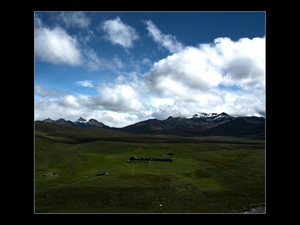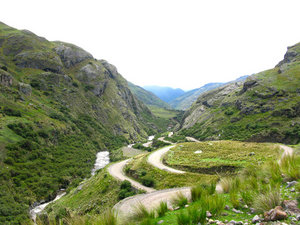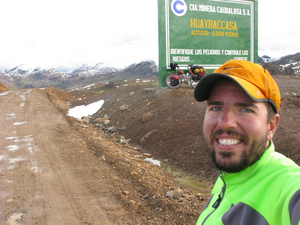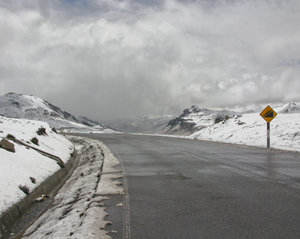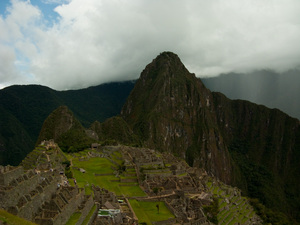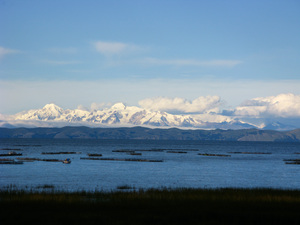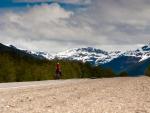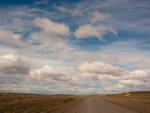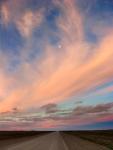Southern Peru
South AmericaAfter acclimatizing in Huaraz for a few days, I rolled out feeling winded and cold. Three months on the coast had sapped my acclimatization. My head doubted my daily distances but my legs remembered what they once were and begged to run. I pedaled through the high mountain paramo, gliding between massive white curtains of rain falling thousands of feet. At times they gave encores to the magnificent glaciated mountains that are the Cordillera Blanca, parting to allow the view. I kept to the pavement, skipping a stunning but hardcore “shortcut” to the Pasturi glacier. I knew the altitude in the next couple days would be a challenge without choosing the most masochistic route. Traffic light, views forever expanding, and dogs ever chasing, I experienced some vey frigid nights.
I found my new bike mounted machete to be of great use. Many dogs run at the sight, but it most amazing utility is the yelling of the canine’s owner upon seeing a crazy gringo on a strange looking bike wielding a huge knife. Moments before, no weapon drawn, they make not even a whisper toward the enemies in hot pursuit.
A few days in, I climbed for hours into freezing pouring rain and eventually in snow to the top of a pass. There I set a new personal altitude record at 4700 meters (15,400ft), but it wouldn’t last for long. Winds howling and bones chilled, I lingered at the top to quickly put on every usable layer I had. Bundled like a child cursed with an overprotective mother I donned: three pairs of gloves, two hats and my helmet, a bandanna over my face, sunglasses, four layers on the bottom, and five on top. I then started the long cold descent down. Wind cut through me and rain stung the small areas of flesh still exposed as I controlled my fall for thousands of feet. I locked my arms tight on the bars, frozen in position, and hoped for warmer weather below. I was both rewarded and cursed. I found a small town where I could fuel up and take a break. The sun shone down on me and I baked in my sumo-like getup. I strolled into a restaurant for a well deserved lunch. Stripping my clothing off, I ordered my meal and shed my garments on the nearby chairs to dry. Feeling good, I continued on, beginning a section of rough road that would last for a few days. The recent rains had flooded some of the road, leaving me cruising through deep puddles, sections where the river had overrun onto the road itself, and once a fairly raging torrent crossing the road where I worried my feet or the Trucker’s tires might be swept and taken into the river. So much for drying out.
I found my way to the next town where a hostel served to dry out my clothes and spend the night. The next day I left, back into the dirt along the valley wall, through roads less visited by tourists than most in this country. Large maguey plants lined the road, as locals screamed “gringo” repeatedly until I waved. Several mud laden sections hindered my way; soft ruts so deep my front panniers shaved furrows of brown that would bring warmth to any woodcarver’s heart. It was near here that I awoke to the trouble that had been stalking me for days. A small rainstorm approached; a simple wall of white, gliding along at the end of the valley, and seemingly on a collision course. I opened my bag, reached in my hand and faltered. I expected that slightly plastic synthetic feel of Seattle high-fashion; my rain jacket was missing. Where could it be? Every bag was inspected, a long haulers most hated chore. It wasn’t there. Where could it be? A few moments of frustration were followed by retrospection and ultimately memory tricks to ascertain the whereabouts. The image became clear in my mind. The jacket sat there on the chair in the restaurant days before. I made my way down to the next town, stashed my bike in a hostel, and hopped a van three hours back to the restaurant to find it closed. I pounded and pounded on the door until a Senora arrived, and there, demonstrating a very real look of desperation, laid out my plea. She smiled and told me yes they had kept it for me. She handed it over and was rewarded, or maybe punished, by my very grateful obligatory hug. When I noticed her outstretched arms in that “Uhhh, what are you doing?” sort of stance I let go and thanked her profusely before boarding a van half way back to the bike. At this intermediate town I was told that there was no transportation in my desired direction after 4pm due to robberies on the road. So, a night passed before the Trucker and I were reunited, somehow I don’t think the bike worried about me like I worried about her that night. The next morning she was safe and sound. I owed one night for the room she stayed in, $1.60.
Glad to have all my gear reunited, I continued. One day up and another over a pass where dropped more than 6000ft down into Huánuco, blistering my hands badly hauling full steam down this rough, sometimes terribly muddy road. I blasted past cars and trucks not able to negotiate turns with the agility of my rig. Looking out for running children while passing through one puebla at 45kph, I missed seeing a speed bump and for the first time ever caught and landed big air with the fully loaded trucker; much to the amazement and enjoyment of the local spectators. Closing out this section meant that I would enjoy that sweet sweet welcomed gentle glide of pavement. Sometimes it’s not until you lose something then find it again that you realize how amazing it really is. Pavement, rain jackets, or people, you decide.
I climbed for days back up to 4300 meters (14,00ft). In Trujillo I had replaced several parts, but could not find everything I needed. My gears were now bigger (more difficult to climb), heavier (steel rather than aluminum), and both my front and back shifters were now ailing and refused to enter my small ring or the two big rings in back. In layman’s terms, all my climbing gears were unusable. Luckily the climb to Cerro de Pasco didn’t get too steep until the very end where I met a local on the way back from the mine. We rode together until the rain got too cold and he opted to hitch the rest of the way. Half way up I shared an unfortunately foul can of tuna and bread with him as he recounted the story of how his brother made his way north to the US / Mexico border. Just before attempting to cross with a coyote he sent a final email to saying he would get in touch once on the other side. That was the last thing he heard from him, now two years ago.
After a few days of being sick in Cerro de Pasco, I was eager to head out into the altiplano which lay to the South. The golden-brown grass covered landscape was littered by llamas and alpacas. I cranked down from the shallow edge of the pass into a giant plain, ringed with the menacing teeth of small peaks in all directions, and watched as rainstorms swept the land like wood shop push brooms at closing time. I skirted Lago Junín, cruising into the headwind, stopping occasionally for a fried or grilled trout to fuel my now strengthened legs.
Days south I began a section avoided by some, but one I had dreamt about years. From Huancayo, I again left the pavement, and began climbing. Roads wound upwards with serpentine grace, ultimately leaving the bushes and eucalyptus trees behind. Only mosses and small plants grew among these high rocks. I had planned on splitting the ascent of what is probably the highest point of the trip into two days, but didn’t see any good camping along the way and my legs still moved easily until there was no turning back. I reached Chonta Pass and the turnoff to Huayraccasa Pass late in the day after seven hours of riding. Hungry but no time to eat, too cold to stop moving, exhausted, terribly winded, sunlight waning, and able to see two approaching storms, I headed for the top. In times when my body tells my brain I can’t go on, I answer with my mantra: keep cranking. Huffing these words through my breathing, too cold and tired to actually speak them, I continued. Vischacas scurried about, but with little energy and little time I barely lifted my head to look. The surrounding mountains, red, green, orange, yellow surrounded and my lungs ached as that famous sign came into view. 5,059 meters (16,558ft), and new personal record. I parked the bike, snapped my photo, bombed back down to Chonta Pass, and down the other side; finding a semi-exposed but passable campsite just after sundown. I was discovered the next morning by a local farmer and his dogs, rousing me from my tent to see the half foot of snow that had fallen in the night and brought a cold wind down from the pass. I cruised down, again toward pavement. Speeding around corners, many times, to find sheep, llamas, or alpacas in my path. Twice I was inches from crashing headlong into a giant filthy woolen pillow that is the rear end of a running llamas as I chaotically parted these seas of livestock.
The next day, I was punished for the descent the day before with yet another 4000+ meter pass. However the views on the other side, and the bar gripping descent more than made up for it. I came around the last bend to the summit, soaking wet from hours of rain riding, a cold wind blowing across the snowfields and over my neck. Cold, tired, hungry, but smiling, I was ready for my close up.
A film crew happened to be at the top shooting some footage for a daily national music show. They were excited to see me and interview me, even in my frigid state. Many cyclists I know have had this experience and many more have local newspaper articles published about them along the way. I had avoided them up until now, but looking back they do make interesting memories and if in print, nice keepsakes from the expedition.
There are descents and sights that are just too beautiful to stop and take a photo. I know this may be hard to understand but sometimes it’s the technical thought that is inevitably needed to take a good photo that will spoil the perfect moment and rip me from that bliss that is the wind in my face, a view so vast a beautiful it has brought a tear to my eye, that glide of smooth pavement, grip of the turning switchback at velocity pulling downward, and the tightening of my stomach, that the word “enjoyment” doesn’t even begin to describe, that keeps me, from taking those photos that I know would be some of the most beautiful of my life. It’s only those moments which are so much more beautiful, that can’t be spoiled, that warrant this selfishness, that create such an addiction and compulsion, that drives me onward and denies you the reader from anything but a mere glimpse, or perhaps, I hope, the seed of a daydream, of what those moments are. This descent was one of these. Huge sweeping mountainsides ran stained with minerals of colors I haven’t seen elsewhere other than the Andes of Peru, capped with snow, and nestled in green blazed by in a gorgous smear of adrenaline and joy.
Direction finding, especially leaving big cities, can be trying at times. After almost 18 months on the road I seldom get lost or backtrack. Ayacucho, however got the best of me. On the way out of town I received eight distinct directional answers from 15 different individuals. The problem lay in my decision to take the road less travelled by, and as you will read, that made all the difference. Toward the end of the day, I realized I was on the wrong road. Instead of a slow steady climb up to 4300 meters, I would yo-yo for two days then finally make the climb up, just to drop down the other side. The morning before the pass, I packed up from the small ravine where I had nestled my tent the night before. As I loaded my front bags I noted my balding front tire; the second layer of rubber showing through in one section. Focused on the task at hand it didn’t even occur to me to change to my spare, my desire to get on the road pulling. This would be my undoing. This section, from Ayacucho to Abancay is generally thought of as one of the most difficult in all of Peru. Some of my friends went out of their way to avoid the suffering, and almost everyone else I personally know ended up bussing it. Rough dirt roads eventually morphed into deeply rutted mud. Near the top of the pass, the steep route became unridable, my tires slipping and sliding as rain and then hail poured down. I crested and flew down the descent, hands aching from gripping the brakes. I hooked a section of tube from my handlebar to my brake, sort of an auto-brake, to slow my rapid descent and give my digits a rest.
I graced the valley walls, finally finding a smooth section of hard packed dirt. The valley dropped down ~500 meters (1600ft) sharply to my left. A pothole approached ahead as I flew at what my speedometer would later tell me was 48 kph. In crossing over to the right side of the road toward the other track, in that split second I noted the steepness of the crown, and in that fraction of a second when my eyes widened, I noted in zen like detail the grittiness of the sand on the side of that crown as my front wheel began to slide and I realized what was happening. Those nanoseconds multiplied into minutes watching my front tire slide sideways, lubricated by speed, wet sand, and enjoyment of fear. Somehow instinct kicked in and as always I clipped out of my pedals. It’s not a choice I make; it’s a reaction that seems to come directly from the muscles in my feet. In an instant I was flying, free of the trucker and gliding towards new adventure. The feeling of impact brought back that smell. That indescribable smell of trauma that I know does not exist and is gone in an instant, but if experienced enough will be remembered along with all the previous adventures where it was found. The feeling of rocks scraping over my front teeth was unmistakable and went on for much longer than possible. Finally, I skidded to a stop, dazed but aware of what had occurred, and opened my eyes. My vision was partially obscured by a roll of skin that had been peeled from the top of my nose and neatly bunched at the end like . My knee was shredded and that usual intermediate period where no pain is felt didn’t arrive. My handlebar bag had opened, a yard sale now blocking this narrow, remote mountain route. Several times I attempted to get up and walk the seven or so feet I had launched from the bike to the bike to take a photo. Each time I was met with excruciating pain from my knee that dropped me back to the dirt. Ten minutes later a truck arrived, picked up my bloody broken body and gear and dropped me at the health center in the next pueblita.
As I walked to the health center, blood seeped from my knee down my leg, from the palms of my hands through my shredded gloves, my elbow, and from my face, streaming into my mouth and down my chin, inviting gasps and coos of “pobrecito!” from the senora’s in the street. Small towns in the mountains in Peru typically have only a nurse, no doctor. This was no different. When I arrived the electricity was out so a dying flashlight was employed as the nurse scrubbed my wounds with alcohol, then iodine. Flap after flap of skin was cut from each wound before they were wrapped up with white cotton and secured with tape. My facial wounds required three stitches, flashlight held high.
Moments of desperation, disappointment, confusion, and panic often pass when first beginning a tour. As a trip like this continues and this “life in concentrate” is experienced one learns quickly that things will be ok. They always turn out ok so there is no use worrying. Eventually you chuckle at the situations that might have phased you in the past and see them with amusement. I am ashamed to say that during this experience I had a moment, there on the ground, looking at my knee and wondering if that was bone I was looking at (it wasn’t) and if it was fractured, where I gave in to despair. It was only a second, immediately followed by a shot of anger at my own thoughts; no point in worrying yet. With luck I would be back on the road in a week. Still the disappointment of taking a bus the rest of the way to Cusco to find more sophisticated medical services stung a bit. The road to Abancay had conquered me and claimed my blood and tissue as it’s prize. My reward is the story, the small scar on my lip, and the many fractures in my two front teeth, I now proudly bear.
After a week of hardly leaving the bed in Cusco, I was able to walk up stairs and took the train to Machu Picchu. Since I was around nine years old I had dreamt of visiting this wonder. Longing for physical exertion I made my way up Huana Picchu in 27 minutes before grabbing my photos and viewing the rest of the sites that is this tourist trap.
After purchasing yet more inadequate mediocre parts and fitting them to the bike, I began the three day climb into the strange land that is the Southern altiplano of Peru and Lake Titicaca. The sun scorches leaving the white skinned lamenting lack of sunscreen and what little shade you find will leave you shivering and wishing for a sunburn. Frigid nights were illuminated by billions of stars blazing through uninfluenced high altitude skies. I rode on, days and days of the same scenery and headwinds passing me by. The mountains of Bolivia loomed across the lake and again I daydreamed of the road ahead. My mind drove my legs with the realization that my visa would soon be running out. 181 days after arriving in Peru, I arrived at the southern border; I paid my one day of overage and crossed into Bolivia.
